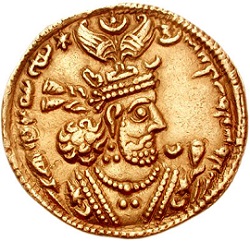On this date (or very close to it) in 628, the Persian emperor Khosrau* II was put to death by the order of his son and usurper.
 Chip off the old block, that boy, since he was taking power the same way as Khosrau himself had done way back in 590. But with the old man’s fall, the Sassanid Empire entered its death spiral: by 651, it would be overwhelmed by the armies of Islam.
Chip off the old block, that boy, since he was taking power the same way as Khosrau himself had done way back in 590. But with the old man’s fall, the Sassanid Empire entered its death spiral: by 651, it would be overwhelmed by the armies of Islam.
Little could the younger Khosrau have conceived of his glorious Persian state laid low by these desert zealots! Persia’s last great pre-Muslim empire flourished in Khosrau’s heyday.
Briefly deposed in his youth, Khosrau reinstated himself with the aid of the Byzantines — ironic aid, in retrospect. After his Constantinople angel Emperor Maurice was deposed and slain in 602, Khosrau availed the pretext of vengeance to make war on Byzantium.
The season of this war would span the entire quarter-century to Khosrau’s own death — and would initially redound to Khosrau’s glory. Byzantium foundered in civil war, coming near the brink of outright destruction under continuous Persian pummeling. Khosrau’s top general Shahrbaraz won a crushing victory in 614, capturing Jerusalem where they carried off thousands of prisoners, the city’s patriarch, and the True Cross. In the years to follow, Persia conquered Egypt and pressed so deep into Anatolia that the Byzantines are said to have considered evacuating the capital to Carthage. Khosrau aspired, wrote Theophanes the Confessor more than a century later, “to seize the Roman Empire completely.”
The fall of the Sassanids, and Khosrau, from this apex was precipitous and entire.
The Byzantines under Heraclius rallied dramatically and in the winter of 627-628 carried Roman arms to the city of Dastagerd, just a short march from the Sassanid capital Ctesiphon. The intrepidity of the counterattack threw the Sassanids into a commotion; Khosrau disgracefully fled Ctesiphon, and in the power vacuum that followed, his heir Kavadh seized power. A usurper cannot afford to found his authority on sentiment; Kavadh not only had his father executed — allegedly by being shot slowly with arrows — but he ordered the deaths of all his half-brothers to extinguish as many future rivals as possible.
The precautions did not grant Kavadh a long reign: he died of the plague later that same year, beginning a dismal progression of feeble claimants overthrowing one another. The Arabs overran Ctesiphon by 636, leaving the rump of the Sassanid state shrinking towards nothingness, and its last emperor to be ignominiously slain by a miller.
Dig into the seventh century Byzantine-Persian frontier during gym time with an ample selection of audio product:
-
The History of Byzantium podcast has treated this period in some detail: for Byzantium, it was a dramatic phoenix-from-the-ashes story, and the running war with Persia is one of its principal themes. Try episodes 44, 45, and 46
The (defunct, but still available) Twelve Byzantine Rulers podcast has a snappy episode on Khosrau’s Byzantine opposite number, Heraclius
The BBC In Our Time podcast has an enjoyable 2011 episode on the Sassanids available here.
* Also rendered Chosrou or Chosroes, among many others.
On this day..
- 1930: Dr. James Snook, Ohio State University professor - 2020
- 1616: Vincenz Fettmilch - 2019
- 1525: Cuauhtémoc, the last Aztec emperor - 2018
- 1785: Horea and Closca, Transylvanian rebels - 2017
- 1975: The Gold Bar Murderers - 2016
- 1800: Roddy McCorley, at Toomebridge - 2014
- 1946: Bela Imredy, Hungarian fascist prime minister - 2013
- 1476: The Garrison of Grandson, by Charles the Bold - 2012
- 2000: Hassan bin Awad al-Zubair, Sudanese sorcerer - 2011
- 1810: Tommaso Tintori, the first guillotined in Rome - 2010
- 1887: Roxalana Druse, the last woman hanged in New York - 2009
- 2002: Monty Allen Delk, in a Three-Pronged Failure - 2008
